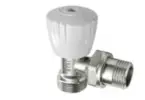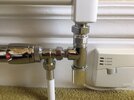Hi everyone. I'm fitting a CH towel rail, with an elbow angle adapter to take an electric element as well as the water. There's no taper on the thread, so the adapter screws in until the thread ends. At that point, the pipe connection is pointing out into the room, which is no good of course. So, I've used a lot of PTFE tape and left it not actually tight. It wound in with a smooth resistance, but now as I fit the pipework it does swivel, if I push.
What do you think? Will it seal like this under 1.5 bar of pressure, or is it doomed and I need to find a better way? Any expert advice would be greatly appreciated!
What do you think? Will it seal like this under 1.5 bar of pressure, or is it doomed and I need to find a better way? Any expert advice would be greatly appreciated!



